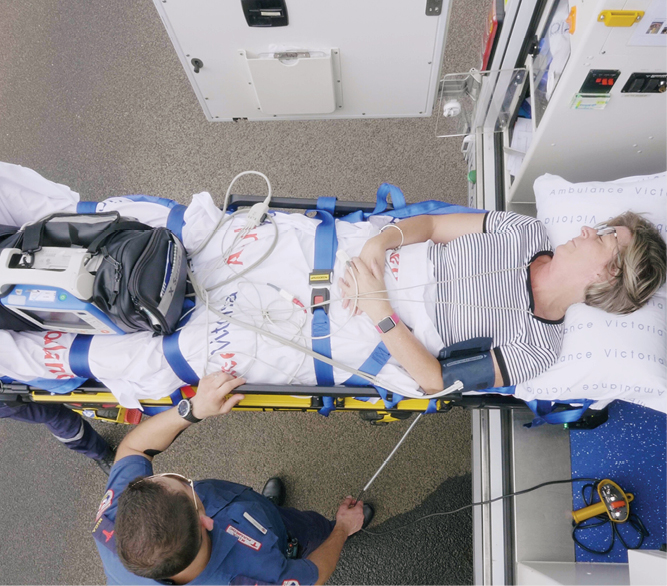Hyper-urgent stroke care essential to save lives

MEDIA RELEASE
Wednesday, December 13, 2023
A new Stroke Foundation audit of around 100 acute hospital services across Australia has found that our nation is falling well below international standards and not meeting national benchmark treatment times to save lives.
The Australian Stroke Alliance is calling for a greater emphasis on coordinated care from the moment a paramedic arrives at the scene of a stroke, as part of its response to the 2023 National Stroke Audit, a snapshot of acute stroke care provided to Australians.
Among the structural changes required across the hospital system, the Stroke Alliance is calling for greater investment in prehospital care which will improve time to treatment. ‘Time is brain’ is a critical principle in early stroke management and leads to better outcomes, and less or no disability. Improved efficiencies also mean fewer unnecessary inter-hospital transfers, thus streamlining an overstretched ambulance system.
“The audit found that the median time from stroke onset to arrival in the emergency department is four hours and 24 minutes – possibly too late to provide essential clot-removal for many patients,” said Professor Geoffrey Donnan, co-chair of the Stroke Alliance.
“Coordinated telestroke means a paramedic works with a hospital-based stroke physician who can make decisions while the patient is in transit in an ambulance, possibly bypassing smaller hospitals in favour of a comprehensive stroke centre. Vital minutes are saved as the emergency department is primed, ready to fast track the patient to a brain scan and possibly mechanical clot removal,” Prof Donnan said.
“Liverpool Hospital has recently broken its own record, treating a stroke patient within 24 minutes of arrival, thanks to improved communication between stroke-smart paramedics and hospital-based physicians. The fast response is a result of a Stroke Alliance pilot based in south-western Sydney where patients are coming to Liverpool from rural and metro locations.
“For those in rural locations, we know that a well-designed telestroke service results in dramatic improvements to care, as we have seen in South Australia.”
Professor Stephen Davis, co-chair of the Stroke Alliance, added that much could be learned from South Australia, a national leader in urgent stroke diagnosis and treatment.
“SA Health’s Rural Support Service introduced Stroke Alliance-designed statewide telehealth in 2022 to serve rural and remote communities, providing life-saving intervention and for a fraction of the price of other telehealth services.”
In the first 12 months in SA:
> Treatment is up to 30 minutes faster
> Twice as many patients are being treated with thrombectomy
> Unnecessary, expensive, time-wasting inter-hospital transfers are down 72 per cent.
The Stroke Foundation, a principal partner of the Stroke Allianace, calls for better system-wide coordination of services, earlier access to time-critical therapies and improved access to stroke unit care.
Key findings of the 2023 National Stroke Audit Acute Services Report:
• Only 38 per cent of all patients with acute stroke reached hospital within the critical 4.5-hour time window for acute stroke treatment. Similarly, to the 2021 results, this indicates that not enough Australians are aware that stroke is a time-critical medical emergency, or they live too far from urgent help.
• Only 29 per cent of patients receive thrombolysis within 60 minutes of arrival in hospital (27 per cent in 2021), and well below rates achieved in the UK and US (both above 60 per cent.)
• Reperfusion treatments (intravenous thrombolysis and/or endovascular thrombectomy), have not increased in Australia in 2023 with 4,815 receiving these therapies (4,899 in 2021).
• Thrombolysis provision was lower in inner regional hospitals (9 per cent) and outer regional hospitals (7 per cent) compared to hospitals in major cities (12 per cent).
• Access to stroke unit care has remained unchanged (72 per cent in 2023 vs 73 per cent in 2021). Receiving treatment in a dedicated stroke unit is the greatest determinant for better treatment outcomes and prognosis.
Results are similar to the annual report data due to be released by the Australian Stroke Clinical Registry (AuSCR). The Registry provides data on over 17,000 stroke episodes during 2022. Combined, these data highlight more needs to be done to improve outcomes for people impacted by stroke.
The Stroke Foundation is a principal partner of the Australian Stroke Alliance.
Media enquiries: Amanda Place, Australian Stroke Alliance: 0411 204 526